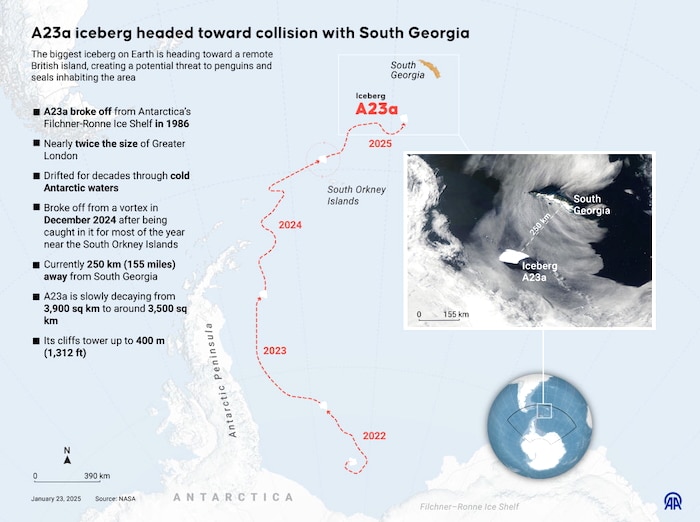This post was originally published on Eco Watch
The biggest iceberg on Earth is once again on the move, on a path that could cause it to collide with South Georgia, an island in the South Atlantic Ocean.
As the BBC reported, the iceberg could ground and break into smaller pieces if it hits the island. As of the morning of Jan. 23, the iceberg is about 173 miles (280 kilometers) from South Georgia. If the iceberg hits and breaks down, it could disrupt feeding access and become deadly for local wildlife.
As the world’s largest iceberg, A23a measures around 1,500 square miles and weighs nearly one trillion metric tons. The iceberg previously broke free from its anchored location between South America and Antarctica in November 2023. Prior to that, it had broken off from the Filchner-Ronne Ice Shelf in 1986 before becoming stuck near Antarctica.
However, in August 2024, the iceberg became trapped inside an ocean vortex before floating free again by December 2024, Smithsonian Magazine reported.
Now, it is on track to cause some disruptions on South Georgia. While there is no permanent human population on the island, it is a biodiverse hub of marine life, tundra plants, penguins, seals, reindeer, and other animals, Britannica reported. The area is also important for fishing and scientific research.
“South Georgia sits in iceberg alley so impacts are to be expected for both fisheries and wildlife, and both have a great capacity to adapt,” marine ecologist Mark Belchier told the BBC.
While the iceberg could potentially impact wildlife, scientists can still learn from its movements and are currently investigating how the A23a iceberg can affect both land and sea, including how its ice melt influences oceanic carbon cycles.
“This isn’t just water like we drink. It’s full of nutrients and chemicals, as well as tiny animals like phytoplankton frozen inside,” Laura Taylor, a Ph.D. researcher at the British Antarctic Survey and the University of Cambridge Department of Earth Sciences, told the BBC.
A23a’s path toward South Georgia is likely to be one of many icebergs to float around the area in the future. While scientists don’t attribute the initial break of A23a from Filchner-Ronne Ice Shelf to climate change, these massive icebergs breaking free from ice sheets could become more common as atmospheric and oceanic temperatures rise, Smithsonian Magazine reported. How the icebergs will impact the ecosystems they pass through is still to be determined.
“We know that these giant icebergs can provide nutrients to the waters they pass through, creating thriving ecosystems in otherwise less productive areas,” Taylor said in a statement. “What we don’t know is what difference particular icebergs, their scale, and their origins can make to that process.”
The post World’s Largest Iceberg, A23a, Is Moving Toward South Georgia Island, Threatening Wildlife appeared first on EcoWatch.





0 Comments